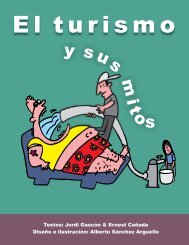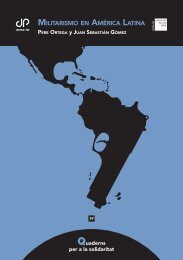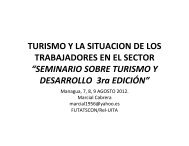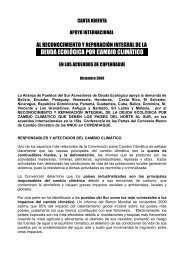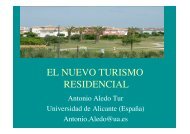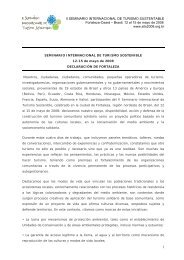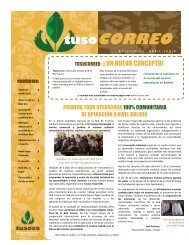Beyond Greening - Tourism Watch
Beyond Greening - Tourism Watch
Beyond Greening - Tourism Watch
Create successful ePaper yourself
Turn your PDF publications into a flip-book with our unique Google optimized e-Paper software.
<strong>Beyond</strong> <strong>Greening</strong>: Reflections on <strong>Tourism</strong> in the Rio-Process | Positioningpapertourism enterprises can be deduced. In protected areas, reserve areas and areas declared ascritical wildlife habitat, local governance is almost non-existent as all decisions regarding thevillages are taken by the Forest Department.The (Draft) Guidelines for Ecotourism Inand Around Protected Areas issued by theMinistry of Environment and Forests onJune 2, 2011 lay out a detailed set offramework guidelines on the selection,planning, development, implementationand monitoring of ecotourism in India.Recognising however, that India’s wildlifelandscapes are diverse, these guidelinesshould be necessarily broad, with specificState Ecotourism Strategies to bedeveloped by the concerned StateGovernments, and Ecotourism Plans to bedeveloped by the concerned authoritiesmandatorily taking into account these guidelines. The following core values should be centralto the guidelines: people-centred, accountable, democratic/participatory/equitable and nonexploitative,which mandatorily will have to be reflected in the state ecotourism strategies.Roles and responsibilities should be enumerated for different stakeholders: StateGovernments, Protected Area management, tourist facilities/tour operators, localcommunities, temple boards and general public. Types of tourism activities allowable shouldalso be enumerated.The Scheduled Tribes and Other Traditional Forest Dwellers (Recognition of Forest Rights)Act, 2006 has not been considered while formulating the draft guidelines. It needs to beensured that the final guidelines will guarantee that the provisions of this key Act are upheld inthe context of the governance and regulation of tourism and rights of forest dwellingcommunities.What Needs To Be DoneIt is important that forests not be seen merely as providing ecosystem services alone but as anecosystem which comprises of the people living in and around the forests including theirhistorical relationship with the forests, the flora and fauna. By turning ecosystems intotourism products, they are also made vulnerable to the market (demand and supply). This isdone without taking into consideration the communities living in these areas who have forcenturies been the custodians of the resources and who have a symbiotic relationship withthem. Further, the life-cycle of the ecosystems themselves is not considered while planning fortourism development in these fragile spaces.Ecotourism, when practiced correctly, has the scope to link to a wider constituency and buildconservation support while raising awareness about the worth and fragility of such ecosystemsin the public at large. It also promotes the non-consumptive use of wilderness areas, for thebenefit of local communities living in and around, and dependent on these fragile landscapes.The first benefit from ecotourism must go to the local people, and in the long-run, capacitybuildingshould be carried out to forge a sustainable partnership between the forestdepartment, tourism department, tourism professionals and local communities. The longterm goal is for communities to own the ecotourism enterprises through active participationin their governance.32



